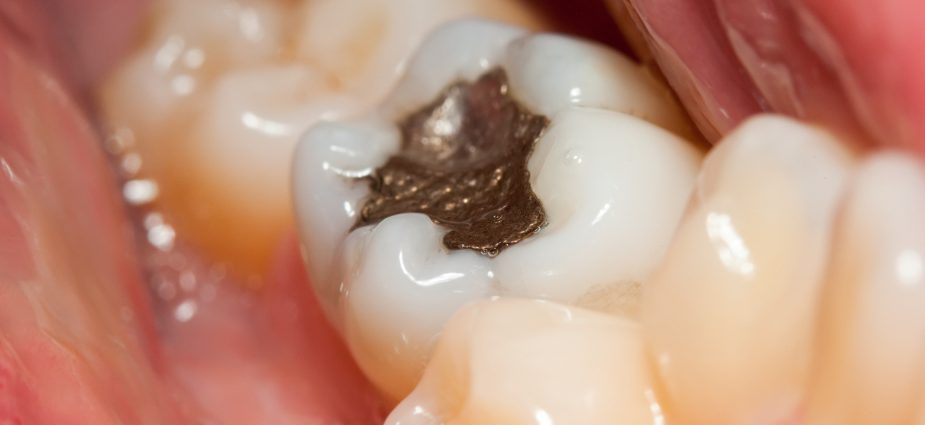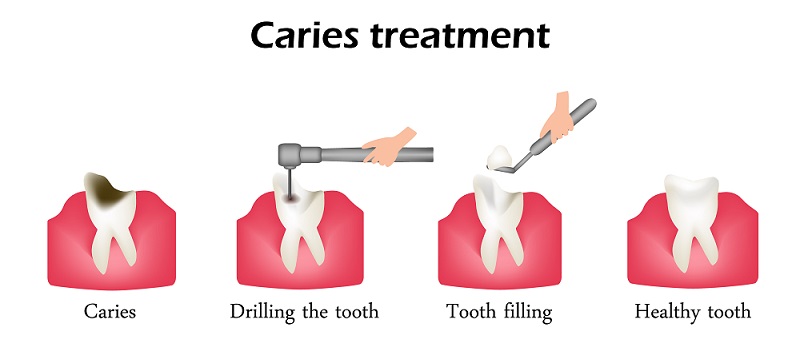Let’s Talk Dental Fillings: Procedure and Costs
Medically Reviewed by: Robert E. Steinberger, DDS

On this page: Consultation | Procedure | Recovery & aftercare | Cost | Porcelain or Composite?
A dental filling is a type of restorative dentistry treatment used to repair minimal tooth fractures, tooth decay or otherwise damaged surfaces of the teeth. Filling materials, which include composite, porcelain and silver amalgam, may be used to even out tooth surfaces for better biting or chewing.
Enamel loss is a common component of tooth decay and may result in tooth sensitivity. In many cases, sensitivity caused by enamel loss will be significantly improved or completely eliminated once an appropriate dental filling material is placed. But in some cases, depending on the extent of tooth decay or damage, the affected tooth may require additional or alternative procedures, including:
- Dental Crowns: Teeth requiring more support than offered by a traditional filling may require a dental crown.
- Dental Implants & Dental Bridges: Irreparable tooth damage requiring tooth extraction may require an implant or bridge.
- Root Canals (perhaps along with antibiotic treatment): Infected, abscessed or nerve damaged teeth may require a root canal procedure.
Consultation and Treatment Planning
One of the more common oral health issues discovered during scheduled cleanings and exams is decay. Your dentist will examine suspect teeth using a dental probe, as well as take an X-ray to determine the extent and exact location of the cavity and decay.
Once it is determined that a filling is needed, your dentist will advise you of your options for filling and sealing the cavity to prevent further decay and damage to the tooth. Based on your medical history, location of the cavity, esthetic needs, biting force, durability, cost, number of visits necessary and your preference, your dentist will determine your best filling option, whether that be direct composite bonding, amalgam (silver), gold or inlays/onlays created in a dental laboratory, or using in-office CAD/CAM equipment.
Your dentist may be able to complete your filling treatment immediately. The area surrounding the affected tooth will be anesthetized (numbed) using a local anesthetic, and if necessary, you also may receive a form of sedation dentistry to ensure your comfort. Keep in mind that if you undergo sedation dentistry, you will not be able to drive yourself after the procedure.
The Procedure
The dentist begins the procedure by preparing the tooth and necessary surrounding areas in order to restore the decay or damage. The decay or damage is removed with a dental handpiece (aka drill) or laser, and the area is cleansed to remove bacteria or debris before the restoration is completed.
The first step in performing a composite filling procedure involves isolation of the tooth using a rubber dam. Tooth isolation is critical in a composite restoration because it prevents moisture from interfering with the bonding process. This requires the placement of various adhesives followed by the composite material, which is then hardened with a special bonding light. The completed composite restoration is both functional and natural looking.
Recovery and Aftercare
After the cavity has been filled, your dentist will discuss steps you can take to prevent decay from forming under or around the filling, or in other teeth.
Brushing twice a day with fluoride toothpaste and flossing with dental floss or an interdental cleaner once a day is advised. Keep appointments with your dentist and hygienist for routine check-ups and teeth cleanings. Depending on your risk for caries, your dentist also may suggest sealants that can be placed over your molars to prevent the build-up of plaque and decay, as well as the use of fluoride mouth rinses as an additional preventive measure. (Make sure the water where you live is fluoridated. If not, use a fluoride rinse or toothpaste to make sure you’re getting needed tooth protection.)
Also, since diet and nutrition affect oral health, it will be important to maintain a balanced diet and limit your intake of sugary foods and drinks, and between meal snacks.
How Much Does Treatment Cost?
Composite fillings are usually more expensive than traditional amalgam fillings because they require a more sophisticated process, more expensive materials and additional office equipment. Composite materials offer an aesthetic alternative to traditional amalgam materials. As such, people who have previously received amalgam fillings often return to their dentist to have them replaced with composite.
The cost of dental fillings depends on a variety of factors, including:
- The dentist who performs the procedure.
- The location where it is performed.
- The type of dental insurance you have. As mentioned above, dental insurance typically does not cover the additional costs associated with composite.
- The number of tooth surfaces that need filling. For example, one tooth may have only one surface affected by decay or damage, while another tooth may have one or more surfaces affected by decay or damage.
On average, amalgam fillings are expected to last approximately 12 years, while composite fillings are expected to last five to seven years. This of course is dependent on your unique considerations, the care with which you treat your oral hygiene and your commitment to continued dental visits.
The cost for amalgam averages approximately $200 to $400 per filling, whereas the cost for resin-based composite, which is determined by the number of tooth surfaces on which the material is placed, ranges on average from $215 to $500 per filling..
Porcelain or Composite?
There are a number of pros and cons associated with both composite and porcelain, and amalgam.
Safety and Appearance: In addition to having a more pleasing and natural tooth-like appearance, porcelain and composite fillings have the potential advantage of not containing mercury or other metals that may contribute to sensitivity or toxicity. Mercury toxicity from amalgam fillings is a controversial subject, though no research to date has been able to show any risks of having mercury as a component of amalgam fillings. However, many patients do have metal sensitivities, and some have reported a metal taste after the placement of amalgam. That said, there has been considerable research evaluating the toxicity associated with composite biodegradation. Mercury toxicity is well established, but further study is needed to fully understand potential composite toxicity.
Durability: Porcelain and composite previously were not as durable as amalgams. However, dental manufacturers have made great strides in improving the strength of composite resin materials, to the effect that composite fillings now have the potential to be used for all teeth, including molars. Furthermore, composite materials often require less tooth preparation and may not weaken the affected tooth as much as amalgam, which often require more extensive tooth preparation. However, amalgam fillings do have a long-term track record and may last significantly longer than porcelain and composite, in addition to being more durable. Composite materials are also more prone to leak and can therefore decay more rapidly than amalgam.
Tooth Shaping: All fillings require preparation of the affected tooth, but less preparation is usually required for porcelain or composite. Typically, this means that less healthy tooth structure has to be removed when placing a composite.
Technique and Time: More than amalgam, the success of porcelain or composite depends on your dentist’s technique. Porcelain or composite restorations also require the use of additional equipment, and the procedure itself requires up to 50 percent more time than the amalgam filling procedure. These factors contribute to the higher costs associated with porcelain and composites. In addition, most dental insurance companies do not cover the additional costs associated with porcelain and composite.
Skill: Most dentists are skilled in porcelain and composite fillings, but their level of skill may vary. Selecting the appropriate dentist is an important factor in treating tooth decay or similar damage. Ask if your dentist has obtained the kind of post-graduate education that allows dentists to refine their skills in porcelain or composite restorations.
If you spend some time understanding the differences between the various restorative procedures and the materials used for each, you will be better informed as to the option that works best for you. Consult with your dentist to determine the treatment time, cost, functionality and aesthetic value of all available restorative treatments for decayed or damaged teeth.
[updated March 28, 2019]
About the Reviewer
 Dr. Robert Steinberger is a top New York dentist with more than 29-years’ experience performing general, cosmetic and reconstructive dentistry services in The Bronx, New York. Dr. Steinberger received his dental degree from the prestigious NYU Dental School before completing his general practice residency at Maimonides Medical Center in Brooklyn. With his highly experienced team at East Tremont Dental, Dr. Steinberger caters to a full range of oral health and dental issues, offering patients the highest standard of dental care, ensuring that each and every one achieves and maintains optimal oral health.
Dr. Robert Steinberger is a top New York dentist with more than 29-years’ experience performing general, cosmetic and reconstructive dentistry services in The Bronx, New York. Dr. Steinberger received his dental degree from the prestigious NYU Dental School before completing his general practice residency at Maimonides Medical Center in Brooklyn. With his highly experienced team at East Tremont Dental, Dr. Steinberger caters to a full range of oral health and dental issues, offering patients the highest standard of dental care, ensuring that each and every one achieves and maintains optimal oral health.







